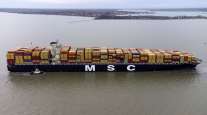Ocean Shippers’ Capacity Exceeding Cargo Demand
“The trades will not return to any sort of equilibrium in the foreseeable future,” said Martin Dixon, head of research projects at Drewry, a London-based company that specializes in ocean freight market forecasting. “We are forecasting that freight rates will continue to fall over the next two years. This will do little to improve profitability. This year is another one with excess supply.”
He estimated world container trade growth at 4% this year and 5% in 2016, well below the 8% additional freight capacity being injected into a market that already was suffering from overcapacity.
“The injection of new capacity increases rate volatility,” Stijn Rubens, a Drewry senior consultant said on a conference call, explaining that carrier behavior also is a factor.
A particular weak spot for rates was westbound shipments from the United States to Asia early this year, when shipment patterns were disrupted by West Coast port congestion linked to a labor contract, Rubens said.
The 40-foot U.S.-Asia average container rate hit the lowest level ever of $1,050 early in 2015, Rubens said.
“Carriers are grabbing extraordinary cargo to assure that the big, new ship is nicely filled,” he said. “The only way to do that is to lower the rates.”
Ocean carriers are, in fact, adding ever-larger ships, typically with 13,000 20-foot container unit capacity, at a rate of one a week this year.
As a result, Rubens said, “Freight rate volatility is likely to get worse in the second half because of the continued influx of these larger ships.”
Next year, the container capacity being added is dropping to 5%.
Dixon said that next year’s demand and supply trends are “more manageable” and at least will not worsen the already severe overcapacity situation.
Container shipping rates on all routes worldwide fell 13% this year, Rubens said, and are expected to fall further.
One reason for that pressure, he said, was the gap of about $700 between the higher prices set through contracts with shippers earlier this year and the lower spot market rate. That gap could prompt shippers to renegotiate or simply move freight on the open market, he said.
General rate increases “have been completely ignored,” Rubens said, as ocean carriers that attempt to raise prices through their trade groups are forced by the market to cut them.
For example, he noted that ocean carriers proposed raising prices $1,200 per 40-foot container in an Asia-Europe market where the actual prices in recent months are barely above that mark.
With rates falling, carriers will continue to focus on cost-reduction efforts, the Drewry consultants said.
A prominent risk is that scheduled sailings across multiple continents will be eliminated to cut capacity and costs, leaving customers to scramble for capacity.
Dixon cited an underlying threat as well.
“Carrier financial stability will become a key feature,” he said, as shippers have to evaluate risk in securing capacity from ocean carriers that chronically lose money.
Another of those steps is so-called “slow steaming” that reduces costs by lowering bunker fuel use. Dixon believes that practice will continue even though fuel prices have fallen.




